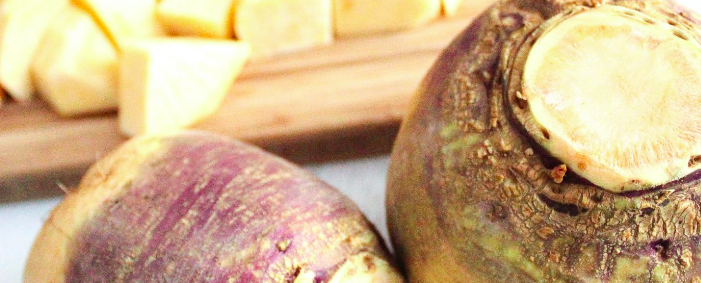
The rutabaga is a biennial plant close to the turnip from which it would result from a cross with a kale. Its leaves are reminiscent of cabbage, and its stem is used for animal feed and edible as a vegetable when young. The bulb, with its light flesh, cooks like a traditional turnip and is full of health benefits.
Characteristics of rutabaga:
- Low in calories;
- Rich in fiber
- Source of potassium;
- Source of vitamin C;
- Presence of vitamin B1 and B9;
What is rutabaga?
Rutabaga identity card
- Season: October to April;
- Family: Crucifers;
- Origin: Sweden;
- Color: White to yellow;
- Flavor: Close to turnip and potato.
Characteristics of rutabaga
When harvested, rutabaga consists of a yellowish-white round root and green leaves.
Differences from related foods
Turnip and swede have long been confused, believing that they were the same species, which explains the confusion about their name. In fact, they are two different species.
Most varieties of turnip have white flesh while that of rutabagas is usually yellow, although the reverse is sometimes true. On the other hand, we can definitely differentiate them by their leaves: those of rutabaga are smooth like those of cabbage, while those of turnip are rough and hairy.
Word from the nutritionist
Prefer small-sized rutabagas which have a softer flesh and can be eaten raw in order to take full advantage of their vitamins and minerals.
Nutritional values
For 100g of raw rutabaga
| Nutrients | Quantities |
| Protein | 1.17 g |
| Lipids | 0.13 g |
| Carbohydrates | 5.7 g |
| Water | 89.6 g |
| Fibers | 2.4 g |
| Vitamin C | 33 mg |
| Vitamin E | 0.3 mg |
| Vitamin B9 | 24 µg |
| Potassium | 349 mg |
| Calcium | 45.2 mg |
| Magnesium | 17 mg |
7 benefits of rutabaga: why eat it?
- Rutabaga is low in calories, so it is suitable for people who want to lose weight.
- Rich in fiber, it stimulates intestinal transit and fights against constipation.
- We find glucosinolates which are compounds with anti-cancer virtues.
- The potassium contained in rutabaga participates in muscle contraction and the proper functioning of the kidneys. Rutabaga is also a diuretic food. Potassium will also fight against blood pressure and help limit the risk of cardiovascular disease.
- There is a not insignificant content of vitamin B9, interesting for pregnant women for the good development of the nervous system of the fetus, and for growing children.
- Source of vitamin C, rutabaga will stimulate the immune system and energize the body.
- Rutabaga contains antioxidants that prevent the risk of cancer development and premature aging.
Choosing the right rutabaga
When you choose it, the rutabaga should be heavy on the hand and have a skin without spots or bruises. Prefer rutabagas of small sizes which have a softer flesh and a subtle taste.
The different shapes / varieties
Depending on the variety, the flesh varies from white to yellow.
Among the varieties that can be found on our stalls, there is in particular the yellow-necked swede, whose root is round; green-necked rutabaga, also with a round root; the yellow of Saint-Marc or the Blanc d’Aubigny with red collar, a long root with white flesh.
Keep well
Rutabaga can be stored in a cool, dry place, protected from light. You can keep it for ten days in the vegetable drawer of the refrigerator.
Preparation of the rutabaga
How to cook it? How to match it?
Rutabaga is easy to prepare and cooks like potatoes:
- Puree with a little butter and nutmeg;
- In soup with other vegetables;
- As a gratin with béchamel and grated Gruyère cheese;
- In the pot au feu;
- Steamed or pan-fried to accompany meats;
- Raw for the youngest rutabagas, grated into a salad with carrots and apples.
Side effects
Irritable bowel syndrome.
Some people with irritable bowel syndrome may experience varying degrees of intolerance to certain foods. Sometimes the intolerance concerns crucifers such as turnips or rutabaga.
Interaction of crucifers with certain drugs.
Indoles, compounds naturally present in crucifers, can in particular decrease the action of certain analgesics such as products containing acetaminophen (Tylenol®, Atasol®, Tempra®) and other drugs combining a mixture of ingredients active ingredients (Benylin®, Contac®, Robaxacet®). People who consume a large amount of cruciferous vegetables should take this into consideration.
History of rutabaga
Rutabaga is said to be the result of a spontaneous cross between a kale and a turnip. This would have happened in Europe during the Middle Ages.
The English name of swede turnip suggests that it was in Sweden, or one of the neighboring countries, that this hybrid was born.